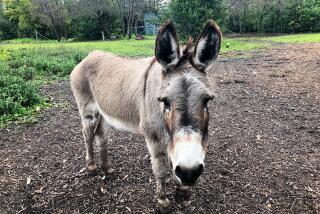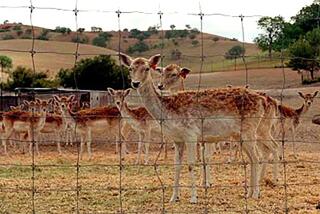Wild Horses Drag Bidders to the Valley
- Share via
Since Michael Cantilla was a boy, a buckskin steed has been galloping through his imagination. He dreamed about catching the mustang and taming it for riding.
On Sunday, Cantilla, now 34, circled the corral at Pierce College in Woodland Hills, looking for the animal of his dreams among the wild horses and burros that the U.S. Bureau of Land Management had put up for adoption. A registered nurse, Cantilla recently bought 2 1/2 acres in Palmdale for his wife, newborn son and, he hoped, that mustang.
The bureau brought 80 mustangs and 30 burros to the San Fernando Valley for the weekend, all of them rounded up from herds on federal land in Northern California and the high deserts of Nevada.
At an auction Saturday, bidding topped out at $375. On Sunday, every remaining mustang and jenny, or female donkey, was offered for $125. Jacks--the male burros--went for $25. Homes were found for about 65 of the animals, bureau spokesman Doran Sanchez said.
Larry Moore II of Carson bought a 4-year-old gelded horse that he’ll call Las Vegas. Moore plans to train the mustang for calf-roping and penning, and use it in a therapeutic riding program for children in Compton. Among the program’s chestnut mounts, the black horse will stand out, he said.
“I saw that one and I liked the color. I liked the way he stood, and I liked his head. I like horses with long heads,” Moore said, looking over his purchase.
A once-over from behind a fence is about all a prospective adopter had to go on. The untrained animals had never had anyone on their backs, and most didn’t seem particularly interested in discovering what that’s like.
“It’s going to take some time” to train Las Vegas for a saddle and bridle, Moore said. “It’s not something that happens overnight.”
On the other hand, the bureau’s Sanchez pointed out, the wild animals “don’t have any bad habits .... You’re starting with an empty vessel, and it will know only what you teach it.”
More than 185,000 animals have been placed in homes since the BLM’s Adopt-A-Horse or Burro Program began in 1973. The program’s slogan invites people to “Adopt a Living Legend,” because the horses are descendants of mustangs that arrived in the 15th century when Spanish explorers reintroduced the horse to North America.
“This is part of history,” Moore said.
The bureau estimates that 45,000 wild horses and donkeys roam the Western states. Periodically, the bureau thins overpopulated rangeland by rounding up the animals for adoption. Drought and recent wildfires have destroyed large portions of the animals’ habitats, sending an additional 6,000 to 7,000 into the adoption program.
The transfer is called an “adoption” because the animals don’t become the property of their buyers until after a yearlong tryout. The bureau doesn’t want to send animals home with anyone who lacks the space, time and money to care for a large animal.
Michael Cantilla left the corral Sunday without his dream horse. But the BLM has a bigger selection at its year-round adoption center in Ridgecrest, not too far from his Palmdale home. There, he figures, the perfect horse might lope over.
“I want a horse to come up to me,” he said.
More to Read
Sign up for Essential California
The most important California stories and recommendations in your inbox every morning.
You may occasionally receive promotional content from the Los Angeles Times.










